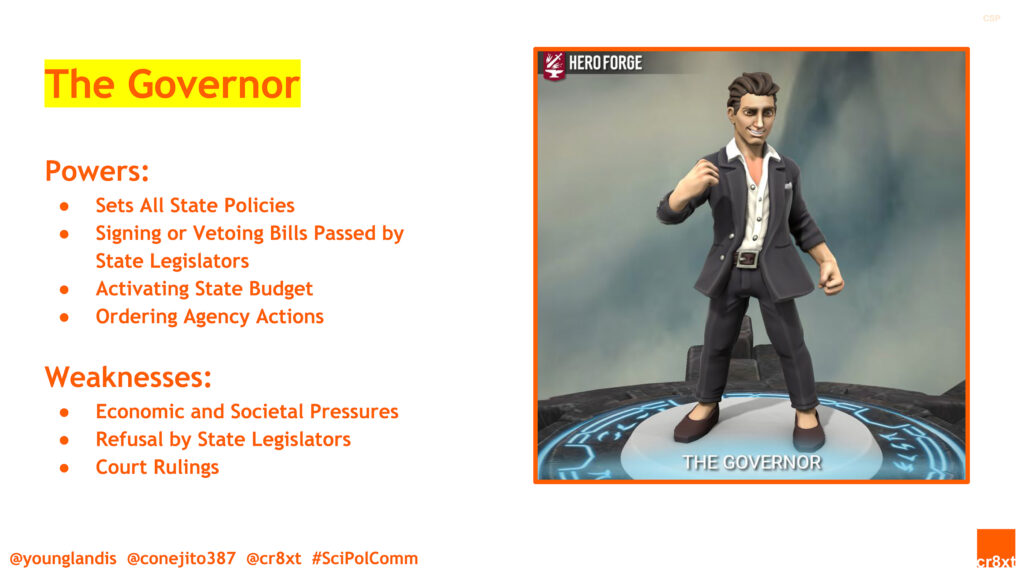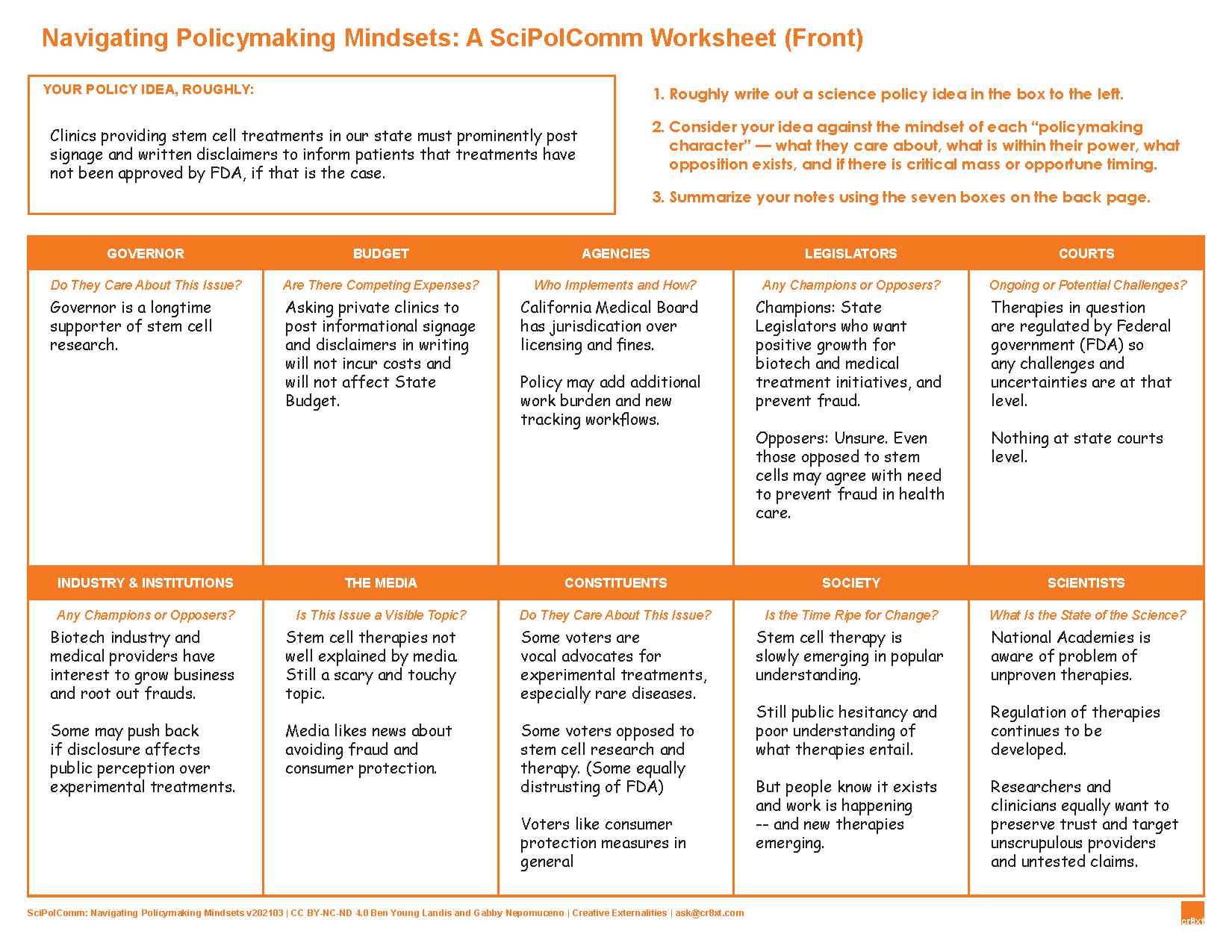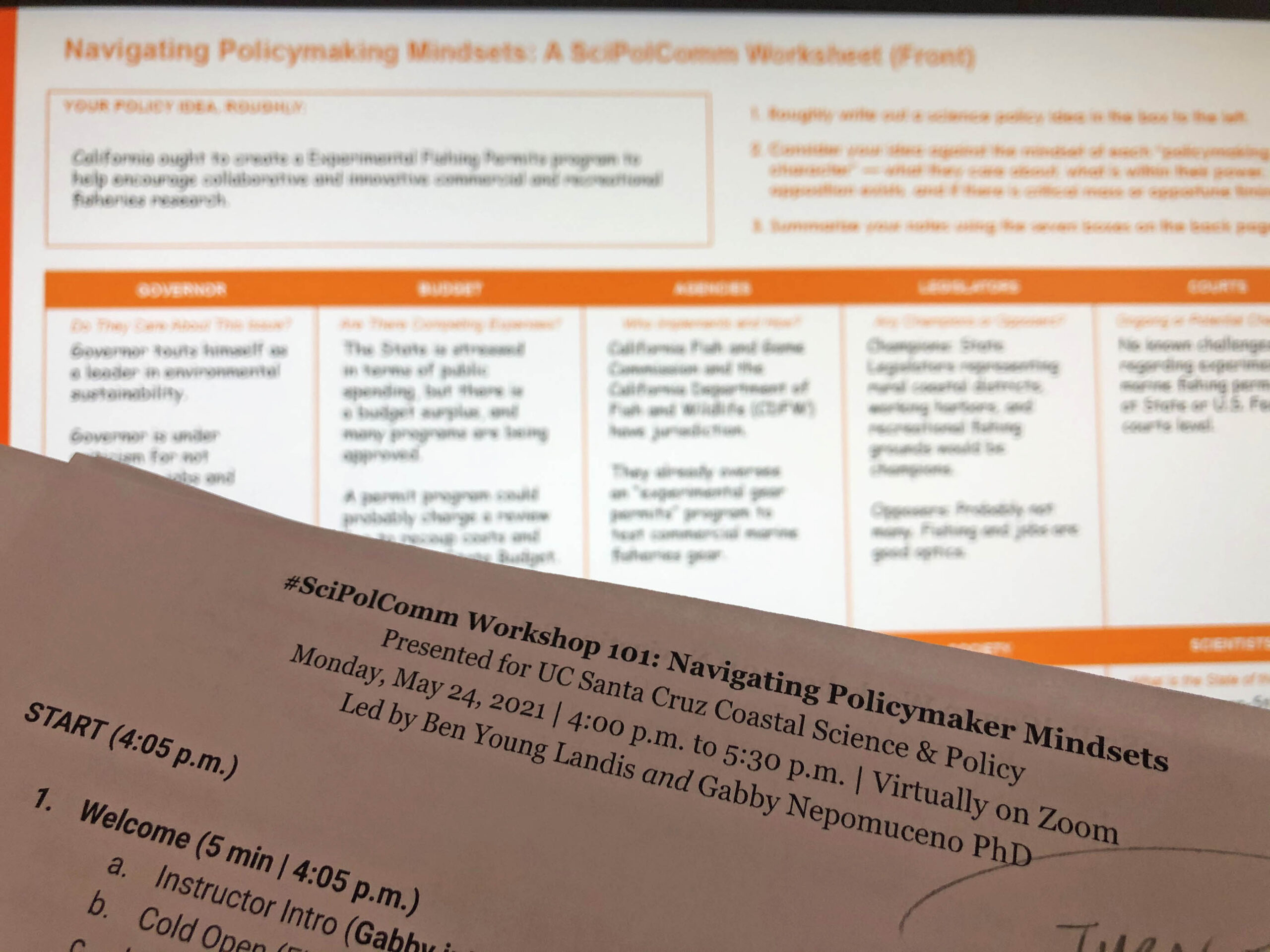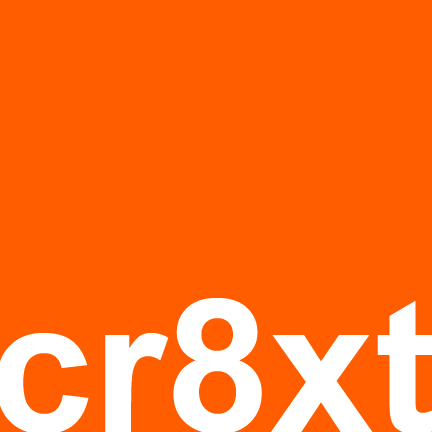Navigating Policymaker Mindsets: A SciPolComm Worksheet is a science policy engagement worksheet created by Ben Young Landis and Gabby Nepomuceno PhD.
- Download instructions at bottom of page
This unique template is designed to help any user think through the political and societal variables that current shape the viability of a science policy idea — and eyeball whether the timing is ripe and forces are aligned to push that proposal forward. Developed in concert with our #SciPolComm series of science policy workshops, this worksheet is paired specifically with the SciPolComm 101: Navigating Policymaker Mindsets (#SciPolMindsets) introductory workshop.
However, this worksheet can be used by anyone else outside of the sciences as well, for policy proposals relating to any issue or sector beyond science and environment. Flexible in nature, the SciPolMindsets worksheet can guide a user in researching the different “characters” whose roles and opinions can dictate the palatability and momentum for public policy, making any background exploration more focused and productive. And while it was designed around state-level policy engagement in California, the template could also be applied to many other U.S. state or local settings. It can be used:
- To prepare for legislative engagement ahead of bill introduction season
- During the strategic planning stage for policy campaigns
- Even as a civic process teaching tool for adults and teens alike
Here’s the story behind its design — and its inspiration from the imaginative world of role-playing games (RPGs).
The Story
Policy trainings for scientists and engineers can take many forms. Some focus on the legislative cycle. Others are formed around a hands-on proposal pitching process. Still others tackle memos and other written engagement. Indeed, cramming policymaking basics within the time constraints of an afternoon workshop is a heroic feat.
Yet the early editions of our #SciPolComm workshops (then titled “Helping Science Inform Policy: Tools for Engaging State-Level Leaders”) tried to do just that, squeezing the legislative process, calendar, communications approaches, and a bill-pitching exercise all in three hours — with only a glossary handout to accompany the lesson.
Not exactly learning friendly!
The more our team wrestled over the curriculum and format, the more we realized two things needed to happen. One, we needed to break up the one course (a legacy of its conference workshop origins) into a multiple-course series. And two, we needed to completely reimagine whatever that first course ought to be.
All along, we were missing the point that fundamentally, scientists are taught to consider questions and decisions primarily from a data and experimental design perspective. But if you asked a policy professional “can you tell me if policy XXX is a good idea”, they would immediately consider a flood of societal, emotional, political, and administrative variables — in addition to the evidence, logic, and logistics.
Clearly, we needed a foundational, anchoring lesson plan to help recalibrate scientists from a researcher mindset to a policymaker mindset. And we needed some sort of interactive scenario and accompanying worksheet to play out the decision process for assessing a policy idea — and to induce this mental shift.
Enter the scene-setting world of Dungeons & Dragons (D&D)…
The Process
As we split up the original SciPolComm curriculum into these three new components, my wonderful friend and frequent collaborator Gabby Nepomuceno PhD took special interest in redesigning the opening course, SciPolComm 101. Having worked as a state legislative staffer, Gabby innately understood our challenge to create a lesson plan and a new worksheet that peered into a professional staffer’s thinking process. We had to capture what all goes through a staffer’s brain, the moment they hear a policy idea pitched to them — then break out that single, instantaneous reaction into its many component steps, considerations, and summary analysis. The worksheet and the in-class activity needed to walk our science-minded participants through this multifactorial process — and help them practice arriving at their own conclusion.
As we broke down the staffer’s mindset, we kept describing their thought process as “figuring out what all the various characters in the policy arena are thinking about at any given time” regarding a particular issue.” The notion of characters was our big creative breakthrough: what if we imagined each policy personality — governors, legislators, industry, media, constituents, etc. — as fantasy characters with powers and weaknesses? Who would trump whom? Which character would actually boost the powers of another, or drag them down? And how would this entire menagerie interact together around a single challenge? At at point, we realized it was possible to teach the policymaking mindset through the metaphor of RPG gaming — and an interactive exercise and worksheet to match!
To make sure we correctly hit the nuances of RPG culture, I called my longtime friend and D&D enthusiast Jacob O. Iversen for advice. Jacob reviewed our early lesson plan concepts, advising Gabby and me that our best in-game parallel was that of the “tavern” — a step where players could deliberate over possible quests, the threats and opportunities ahead, and decide whether to proceed. Essentially the same step we wanted our workshop participants to center on.
Everything clicked from there on, and the design fun began. Using HeroForge® — a 3-D character designing portal popular with RPG players — I built visual personas representing the 10 “policy characters” we settled on, writing out strengths and weaknesses as glimpses into their real-world roles and vulnerabilities. To simulate the deliberation process and put our participants in the player’s seat, Gabby and I wrote out a “dungeon master” script, telling a short story dripping with clues about the motivations of each policy character reacting around a single policy proposal. Then, using our newly designed SciPolMindsets worksheet, our workshop participants could piece together the clues they heard and assess these competing motivations — then deliver their very own verdict on whether this particular “policy quest” was worthy of proceeding.
I absolutely love designing tools and curriculum that are practical and flexible across all possible scenarios and issues — but equally importantly, easy and fun to use. Our SciPolMindsets worksheet is my latest favorite example of this design spirit, we feel this can be a helpful tool for anyone — scientists or otherwise — curious to grow their policy engagement savvy. Use our worksheet to parse out the policy and politics news of the day, and map out the motivations of these different policy characters whose decisions shape our very society. You just might find out whether your own policy idea is a quest worth taking on!
— Ben Young Landis
Gallery





Activate
The Navigating Policymaking Mindsets worksheet is available as a free download. We encourage everyone to use it and share it — widely!
Per the Creative Commons license (CC BY-NC-ND 4.0) we have assigned it, you must:
- Give attribution. Please credit authorship of this worksheet as “Ben Young Landis and Gabby Nepomuceno”. You may do so in any reasonable manner, such as crediting us on a presentation slide or webpage, but not in any way that suggests the we endorse you or your use (unless we have!). You must also display the Creative Commons license — so your text might read something like “Created by Ben Young Landis and Gabby Nepomuceno. Shared under Creative Commons License CC BY-NC-ND 4.0“.
- Avoid commercial use. You may not use this worksheet for commercial purposes, such as teaching your own fee-based workshop. We reserve all rights for the commercial use of this worksheet and related curriculum.
- Not create derivatives. You can only redistribute this worksheet in its originally form. If you remix, transform, or build upon this worksheet and its design, you may not distribute the modified file.
Additionally, we would love it if you listed Creative Externalities and linked to this webpage or our email ([email protected]) in any “For More Information” language. Thanks!
Download
- Creative Externalities – Navigating Policymaking Mindsets Worksheet (PDF | 144 kB)
- Creative Externalities – Navigating Policymaking Mindsets Worksheet – Stem Cell Therapy Example (PDF | 174 kB)
- Creative Externalities – Navigating Policymaking Mindsets Worksheet – Fisheries Example (PDF | 180 kB)
Credits
Creators: Ben Young Landis and Gabby Nepomuceno PhD
Completed: March 2021
Creative Direction: Ben Young Landis
Designers: Ben Young Landis and Gabby Nepomuceno PhD
Product Testing: Gabby Nepomuceno PhD, Sarah Brady PhD, Debra Cooper PhD, and Jacob Iversen
Additional Rights: HeroForge® and HeroForge design elements are courtesy of Sky Castle Studios LLC

